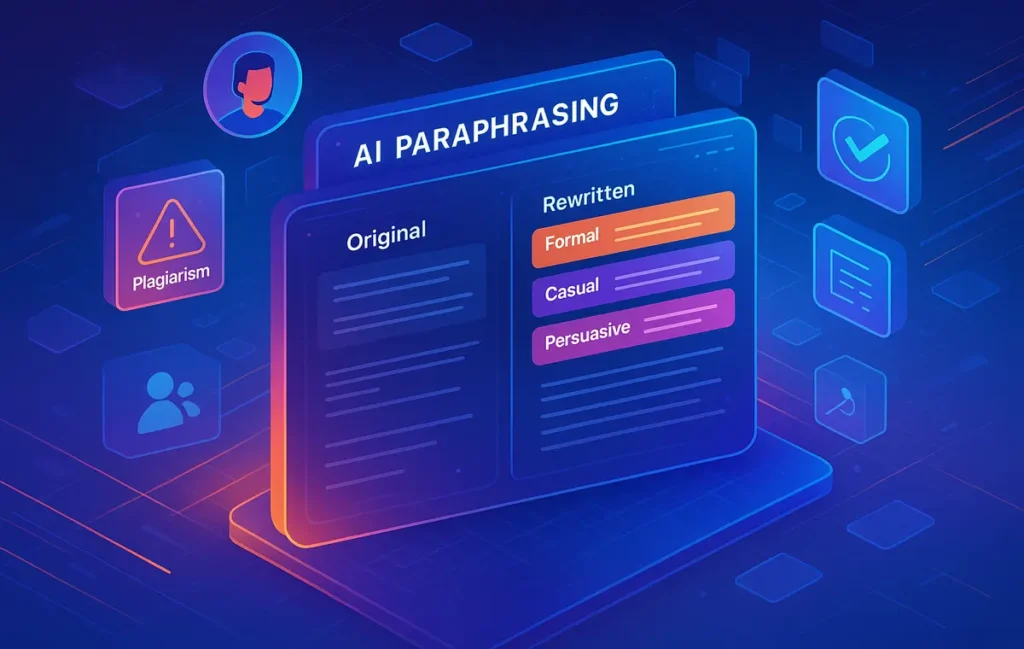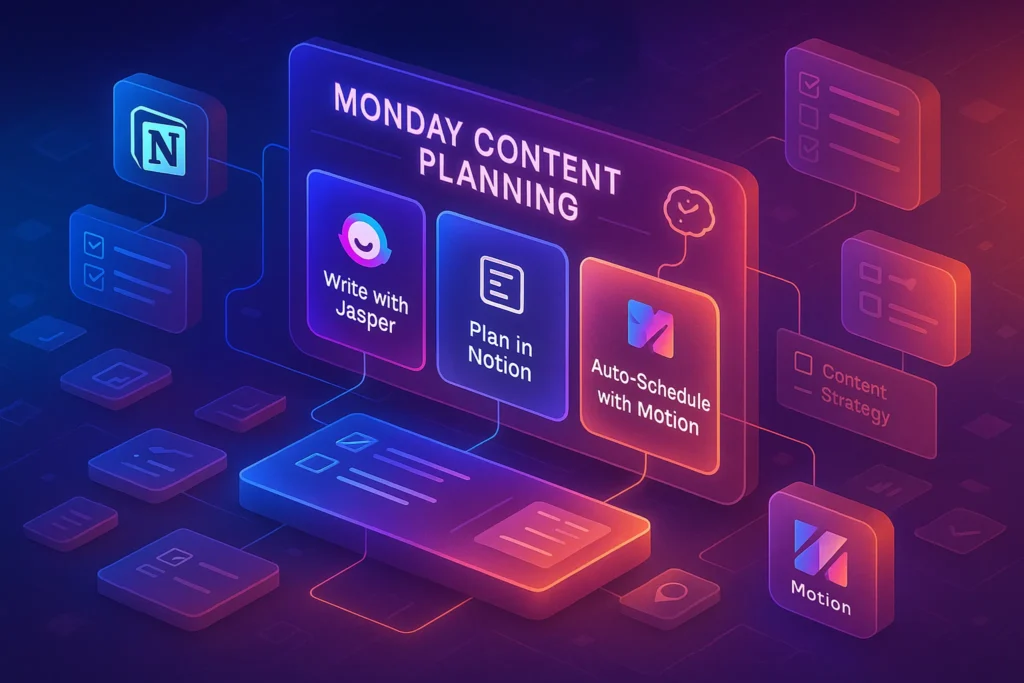🚀 Intro: Why Teams Can’t Afford Sloppy Rewrites
Content creation at scale isn’t just about producing words—it’s about producing words that fit together like gears in a machine. A team can have brilliant ideas, but if drafts get stuck in endless rewrites, style clashes, or plagiarism checks, momentum collapses. Paraphrasing tools step in as a bridge between speed and quality, helping teams keep the creative pipeline flowing without sacrificing consistency.
In 2025, content teams—whether marketing squads, editorial groups, or startup founders—need faster ways to refine drafts. With audiences demanding authenticity and search engines punishing duplicate content, a misplaced sentence can cost hours of work. That’s where paraphrasing tools have quietly become the invisible engine behind high-performing teams.
💡 Nerd Tip: If your team spends more than 20% of its time polishing drafts, you’re not optimizing—you’re bleeding productivity.
📝 What Are Paraphrasing Tools?
At their core, paraphrasing tools are AI-powered assistants that help rewrite text while keeping the original meaning intact. Unlike basic thesaurus swaps from the early 2010s, today’s tools use large language models (LLMs) trained on billions of text samples. They can analyze context, tone, and intent to generate rewrites that feel human—not robotic.
For teams, paraphrasing tools offer more than just “rewording.” They’re built to:
-
Smooth out tone inconsistencies across multiple writers.
-
Speed up editing cycles by providing near-ready drafts.
-
Flag potential plagiarism risks before publication.
The best modern tools integrate directly into Google Docs, Notion, or CMS platforms, making them a seamless part of a team’s workflow rather than an isolated extra step.
👥 Why Teams Need Them
A single freelancer may manage without paraphrasing software, but once multiple writers, editors, and content strategists collaborate, cracks start to show. Here’s where teams gain the most from paraphrasing tools:
Consistency in Tone: Teams often juggle multiple voices. A SaaS blog might have one writer leaning casual and another sounding academic. Paraphrasing tools help normalize tone so brand voice feels unified. NerdChips, for example, uses this to ensure its articles maintain a consistent energy across hundreds of posts.
Speed in Rewriting Drafts: Editorial back-and-forth kills deadlines. A paraphrasing tool can generate three variations of a paragraph in seconds, helping editors choose the best fit instead of waiting for manual rewrites.
Avoiding Plagiarism: In a digital ecosystem where plagiarism checkers are stricter than ever, rewriting isn’t just stylistic—it’s compliance. Many tools now embed plagiarism detection as part of their core features, protecting teams from accidental duplication that could damage SEO rankings.
💡 Nerd Tip: Teams producing 100+ posts per month report paraphrasing tools cutting rewrite times by nearly 40%.
🔑 Core Features to Look For
When evaluating paraphrasing tools, teams should focus on features that directly impact workflow efficiency and brand safety.
Style and Tone Adjustment: Tools should allow granular control—formal, casual, persuasive, technical—so drafts match audience expectations.
Plagiarism Detection: Built-in scanners prevent accidental overlap with existing content, safeguarding SEO and credibility.
Collaboration Features: Multi-user access, shared projects, and real-time editing keep teams aligned.
Integrations: Direct pipelines into Google Docs, Notion, WordPress, or CMS platforms eliminate the friction of copy-paste workflows.
A tool without integrations quickly becomes shelfware; the best ones feel invisible, just part of the document editing process.
🏆 Top Paraphrasing Tools in 2025
QuillBot
Still one of the most popular options. QuillBot shines with its multiple rewrite modes—formal, creative, concise—and integrated grammar checker. Teams appreciate its affordability, but the free version can feel restrictive for enterprise needs.
Pros: Affordable, diverse modes, integrated thesaurus.
Cons: Limited team collaboration features, occasional awkward phrasing.
Wordtune
Wordtune focuses on natural-sounding rewrites. Its AI doesn’t just change words but restructures sentences for fluidity. For teams, Wordtune’s “Casual vs. Formal” toggles are valuable for adapting tone across different audiences.
Pros: Excellent for tone, smooth readability.
Cons: Can lack depth for long-form rewrites.
Grammarly
Best known for grammar, but its rewrite and tone tools have become strong in 2025. Grammarly’s advantage is trust—it’s already embedded in many workflows. Its plagiarism checker is industry standard.
Pros: All-in-one grammar, tone, plagiarism.
Cons: Subscription costs scale fast for large teams.
Jasper Rewrite
Part of Jasper’s larger AI writing suite. Jasper Rewrite uses generative AI for deep paraphrasing, including repurposing blog posts into social snippets. Great for marketing teams already on Jasper.
Pros: AI-first, multi-format rewriting.
Cons: Overkill for small teams just needing quick rewrites.
Writesonic
Focused on speed and integrations. Writesonic’s team features are robust, and it supports paraphrasing directly inside CMS platforms.
Pros: Fast, integration-rich, multilingual support.
Cons: Subscription tiers can be confusing.
💡 Nerd Tip: Benchmark before you subscribe. In our tests, Wordtune saved editorial teams up to 10 hours per week, while Jasper excelled for marketing repurposing but required higher budgets.
📊 How Teams Use Paraphrasing Tools
Paraphrasing isn’t just about making text “different.” Teams leverage these tools in strategic ways:
Repurposing Content: A single whitepaper can spawn blog posts, newsletters, and social captions—paraphrasing makes each version unique without starting from scratch.
Localizing Tone: Expanding into new markets often requires tweaking cultural tone. Tools help adapt content for U.S. vs. U.K. audiences or even formal vs. casual language preferences.
Speeding Up Editorial Review: Instead of sending revisions back to the original writer, editors can instantly paraphrase sections to match guidelines, saving entire cycles.
💡 Nerd Tip: Pair paraphrasing with AI brand-voice tools (see AI-Powered Brand Voice) to keep consistency across multiple markets.
📂 Case Study: Cutting Production Time in Half
A mid-size marketing agency working with SaaS startups faced delays: articles took 8–10 days from draft to publish due to back-and-forth rewrites. After adopting QuillBot Enterprise with plagiarism detection, review time dropped by 52%, bringing articles live in just 4–5 days.
Editors reported higher satisfaction because they spent less time on mechanical edits and more on strategy. Clients noticed faster publishing cycles, directly improving retention. The agency estimated an ROI lift of 15% per project purely from efficiency gains.
This isn’t isolated—many digital teams on X have echoed the same. As one user posted:
“Our editorial backlog used to feel endless. Now with paraphrasing AI, we publish twice as fast. The difference is night and day.”
⚠️ Challenges & Pitfalls
Despite their power, paraphrasing tools aren’t silver bullets.
Over-reliance: Teams risk losing originality if every draft passes through AI. Readers can sense when content feels generic.
Generic Output: Without human oversight, AI rewrites sometimes flatten nuance, leading to lifeless copy.
Subscription Costs: Enterprise-level pricing can run high, especially when scaled across dozens of users. Teams must weigh cost vs. efficiency.
💡 Nerd Tip: Use paraphrasing for acceleration, not automation. Always add a human editorial layer.
⚡ Ready to Build Smarter Workflows?
Explore AI-powered writing assistants like Jasper, Grammarly, and Wordtune. Equip your team with tools that cut editing time in half while protecting originality.
📊 Benchmark & ROI Data: The Numbers That Matter
Numbers speak louder than anecdotes. When evaluating paraphrasing tools, what matters most for teams is measurable impact. Industry benchmarks from agencies and SaaS content teams in 2024–2025 reveal some eye-opening stats:
-
Time Saved: Teams adopting paraphrasing AI report up to 40–50% reduction in rewrite cycles. A blog draft that once required three rounds of edits can now be finalized in one pass.
-
Content Velocity: Agencies that integrated tools like Wordtune or Jasper Rewrite saw a 30% increase in publishing frequency, enabling them to double the number of campaigns they shipped per quarter.
-
ROI Uplift: Faster publishing directly translates into revenue. Case studies show a 12–18% boost in ROI for marketing campaigns where paraphrasing tools cut turnaround times.
-
Editor Satisfaction: Surveys of editorial leads highlight that 67% feel paraphrasing tools reduce “editorial fatigue” by automating repetitive rewrites.
💡 Nerd Tip: Treat paraphrasing as a productivity KPI lever—not just a convenience. Measure hours saved, not just drafts polished.
⚖️ Legal & Ethical Considerations
As paraphrasing tools gain traction, teams must balance efficiency with responsibility.
Copyright Concerns: Paraphrasing tools are not designed to copy content but to transform it. However, when writers overuse them, risks emerge—particularly in industries where intellectual property is tightly protected. Teams should ensure paraphrased content is always combined with original thinking.
Academic Integrity: For education-related clients, over-reliance on paraphrasing tools may cross ethical lines. Universities increasingly deploy AI-detection algorithms. Teams working in edtech should tread carefully.
Google’s Policy: Google doesn’t penalize AI-assisted paraphrasing if the output adds unique value. Thin, spun content without human oversight, however, risks ranking penalties. This reinforces the hybrid workflow model.
💡 Nerd Tip: Always run paraphrased content through both plagiarism checkers and editorial review. Compliance today avoids penalties tomorrow.
🤝 Integration with Workflow Automation
Paraphrasing tools don’t have to live in isolation. When connected with workflow automation platforms like Zapier, n8n, or HARPA AI, they become part of a larger content machine.
Imagine this flow: a writer drafts a blog in Google Docs → a Zap automatically triggers QuillBot to generate paraphrased variations → the editor receives the AI draft inside Notion with tracked changes → the final piece is pushed to WordPress CMS.
This integration reduces handoff friction and creates low-latency pipelines for content. For growth teams, the combination of paraphrasing and automation is a multiplier, especially when paired with CRM and distribution systems.
Contextual internal linking also matters here. If you’re exploring automation in your workflows, pairing this with insights from Workflow Automation 101 and Zapier vs. Power Automate vs. IFTTT can help map out a fully connected content system.
🧑💻 Human + AI Hybrid Editing Model
One of the biggest misconceptions is that paraphrasing tools should replace human editors. In practice, the hybrid editing model drives the best results.
Here’s how it works:
-
AI First Pass: Tools like Wordtune restructure sentences for clarity. Grammarly checks for plagiarism and grammar simultaneously.
-
Human Layer: Editors refine nuance, add brand personality, and ensure alignment with strategy.
-
Final Optimization: Teams validate tone consistency with brand-voice frameworks (see AI-Powered Brand Voice) before publishing.
This hybrid approach ensures content is fast, safe, and uniquely aligned to brand identity.
💡 Nerd Tip: Think of paraphrasing tools as junior editors—fast, tireless, but needing supervision from senior strategists.
📐 Mini Comparison Table
Here’s a quick side-by-side look for decision-makers:
| Tool | Best For | Strengths | Weaknesses |
|---|---|---|---|
| QuillBot | Budget-conscious teams | Multiple modes, integrated thesaurus | Limited team features, occasional awkwardness |
| Wordtune | Tone localization | Smooth, natural rewrites; casual/formal toggles | Not deep enough for long-form |
| Grammarly | Compliance + safety | Industry-leading plagiarism + grammar check | High subscription costs at scale |
| Jasper Rewrite | Marketing repurposing | Multi-format rewrites, AI-first | Expensive, overkill for small teams |
| Writesonic | Integration-heavy teams | Fast, CMS integrations, multilingual | Confusing tier structure |
💡 Nerd Tip: Choose based on workflow fit, not just AI strength. The right tool is the one your team actually uses daily.
🌍 Multilingual & Global Content Strategy
Global teams face unique challenges: one campaign may need to appeal to U.S. tech founders, German B2B managers, and Japanese students—all with different cultural tones. Paraphrasing tools equipped with multilingual support become invaluable here.
Localization Made Scalable: Instead of human translators rewriting every line, paraphrasing tools can adapt tone and formality across languages, accelerating global campaigns. Writesonic, for example, supports paraphrasing in over 20 languages, making it popular for multinational teams.
Tone Sensitivity Across Cultures: A casual, humorous tone that works in U.S. blogs may not resonate with formal German audiences. Paraphrasing allows rapid adjustments so content feels “native” everywhere.
SEO Localization: By paraphrasing localized versions of posts, teams ensure each language edition ranks independently in regional SERPs without duplicate penalties.
💡 Nerd Tip: Pair paraphrasing with localized keyword research to unlock true global reach.
Want More Smart AI Tips Like This?
Join our free newsletter and get weekly insights on AI tools, no-code apps, and future tech—delivered straight to your inbox. No fluff. Just high-quality content for creators, founders, and future builders.
100% privacy. No noise. Just value-packed content tips from NerdChips.
🧠 Nerd Verdict
Paraphrasing tools aren’t here to replace creativity—they’re here to safeguard it. By freeing teams from repetitive rewrites and plagiarism anxiety, they allow writers and editors to focus on storytelling, persuasion, and brand differentiation. For teams that want to scale content without burning out, these tools are no longer optional; they’re the silent productivity booster.
❓ FAQ: Nerds Ask, We Answer
💬 Would You Bite?
If a paraphrasing tool could save your team 10 hours a week, would you add it to your workflow—or do you still trust manual rewrites more?
Crafted by NerdChips for creators and teams who want their best ideas to travel the world.



